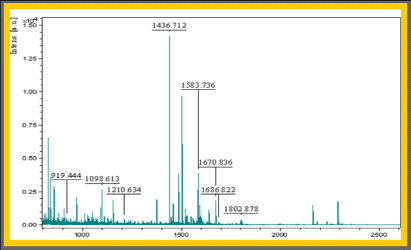Data Analysis
MS Data Analysis

MALDI-MS finger print area of a SYPRO®-Ruby stained 2D-gel spot.
Instrument: UltraflexTMTOF-MALDI-MS (Bruker Daltonics, Bremen, Germany).
Sample preparation: GyrolabTM MALDI SP1 by Gyros AB (Uppsala, Sweden).
(Courtesy of Dr. Irrgang, Max-Volmer-Institut, Technische Universität Berlin, Germany)
The high sensitivity, mass accuracy and resolution already achieved by nowadays mass spectrometers shifts the need for further improvement towards sample preparation.
Protein identification by mass spectrometry for most proteins requires cleavage by proteolytic enzymes. The resulting peptide fragments need to be solved and transferred to either MALDI-MS targets or into an ESI-MS capillary. The quantitative recovery - for example out of the poly-acryl-amide matrix of SDS-gels - and transfer into the analyzing mass spectrometric instrument - ideally of all resulting peptide-fragments, is a challenge which is only partially met throughout most experiments.
For successful ionisation by Matrix Assisted Laser Desorption Ionisation-type instruments peptides need to be deposited on top or close to the top of a crystallized matrix substance. Experimental factors like (1) matrix type, (2) the hydrophobicity of the matrix solvent, (3) the hydrophobicity of the peptide containing solvent(s), (4) the relation between sample and matrix, (5) the amount of contaminating peptides and (6) anchor geometry and coating, determine analytically important factors like crystal dimensions of the matrix, the absolute amount and the variety of different peptides present, as well as the position and degree of dispersion of the crystalls within the heterogeneous arrangement of a MALDI-target preparation.
While well-tuned parameters allow to fully make use of an usually high instrument performance, ill-tuned sample preparation parameters may lead to complete failure independent of how superb the features of the analyzing mass spectrometer might be.
For acidic peptide mixtures solved in aqueous or low organic solvent media MALDI-target preparation exhibiting a more standardized profile can be obtained using the GyrolabTM Maldi-sample preparation device. Under these conditions protein identifications by MALDI-MS fingerprinting can be obtained from <100 nL sample for moderately posttranslationally modified transcripts of sequenced genomes. MALDI-MS fingerprinting spectra suitable for protein identification can be obtained from 2D-gel spots containing <300 atto-mol protein. MALDI-MS fingerprinting can be done at a throughput of more than one hundred samples per instrument and day.
Electro Spray Ionisation mass spectrometry on the other hand has its edge in experimental situations where de-novo sequence information is needed. nano-LiquidChromatography-ESI-MS can reach a sensitivity of ~20 fmol protein per 2D-gel spot, however, the likelihood to obtain sequence stretches of useful lenght significantly increases if more material can be made available.
As for MALDI-MS, experimental factors like (1) the type of capillary or LC-coupling used, (2) the hydrophobicity of the peptide containing solvent(s), (3) the amount of contaminating peptides and salts as well as to a good extent (4) the experience of the instruments operator strongly influence analytically important parameters like the spray stability and the ease of selection of relevant peptides for MS/MS analysis. Since the amount of contaminating peptides and salts is difficult to standardized for all spot digests of a 2D-gel spot set, because of varying protein content, differing hydrophobicity properties of the proteins, and difficult to standardize concentrating or desalting procedures, parameters like needle position or cone voltage have to be adapted to obtain good sprays for all samples. The necessity of repeated operator intervention due to varying sample properties can reduce the potentially high throughput of this method (for uniform samples) to as low as 1-2 samples per instrument and day.
SYPRO® is a registered Trademark of Molecular Probes Inc., Eugene (USA)
UltraflexTMis a Trademark of Bruker Daltonics Inc., Billerica (USA)
GyrolabTM is a Trademark of Gyros AB, Uppsala (Sweden)